Highway 16 running through parts of north-central Alberta and into mainland British Columbia has a second, more ominous name that’s recognizable to most — the Highway of Tears. This stretch of highway was given this name because of the number of Indigenous Women, Girls, 2-Spirit People, and countless others rooted in Indigenous Nations who were either murdered and found along this highway or went missing while along this highway.
There have been initiatives like the National Inquiry into Missing and Murdered Indigenous Women and Girls (MMIWG) that have made great strides to address this issue and educate the public. But, in 2011 a young woman and her father launched their own awareness campaign from people who have their own roots with Indigenous Nations.
Addressing MMIWG from a lived-Indigenous experience
Raven Lacerte and her father Paul started the Moose Hide Campaign and included one distinct symbol as a commitment to ending gender-based and Indigenous targeted violence — wearing a pinned square of moose hide.
To this day, the Moose Hide Campaign organization distributes these pins along with information cards as a gift of medicine. Adding to the Indigenous lens, the website suggests a $1 donation when ordering gifts of medicine as a gift of reciprocity and helping to ensure the Moose Hide Campaign remains sustainable.
Moose Hide Campaign’s main awareness event is its walk in Victoria, British Columbia, on May 15 — but this is far from the only Moose Hide Campaign event. Dozens of individual walks are happening across the country, including one in Edmonton at City Hall.
In addition to the walks, it’s also encouraged to fast as part of this awareness campaign. In many Indigenous Nations and communities, fasting is seen as a symbol of your commitment and a way to deepen your intention towards this commitment. It’s encouraged, but not required, to fast from sunrise to sunset to further solidify your resolve.
Moose Hide Campaign events and how you can get involved
This is a very-high level overview of this immensely impactful movement. The wisdom and knowledge shared by the Lacerte family and the rest of the Moose Hide Campaign team illuminates many of the issues faced by women, girls, 2-Spirit Peoples, and other Indigenous Peoples while firmly rooted in Indigenous culture and community — an important perspective for us all to listen to and gain a better understanding from.
Discover more about the Moose Hide Campaign and how you can showcase your commitment to ending gender-based and Indigenous Peoples targeted violence at Edmonton City Hall.
The 2020s has been an important decade for Canada’s relationship with the Indigenous Nations. We’re seeing large institutions like Canada’s federal government acknowledge and recognize the atrocities committed against Indigenous Peoples.
One incredibly important stride forward was the publishing of the Final Report from the National Inquiry into Missing and Murdered Indigenous Women and Girls (MMIWG). This more than 700-page report highlights interviews with more than 2,300 people affected by violence against Indigenous People.
These stories illustrate the challenges faced by women and girls, and the continued violence against members of the 2SLGBTQIA+ community. By reading this document, we can gain better knowledge on the marginalization experienced by Indigenous Peoples — and ultimately, have the wisdom and perspective to know what we can each do individually to help create a more equitable world.
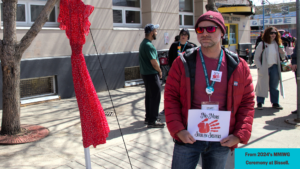
The Four Key Areas of Rights for Indigenous Peoples
In addition to the 231 recommendations the report makes to help end violence and marginalization against Indigenous Peoples, it highlights four key areas of rights for Indigenous Peoples and provides explanations as to how each help work towards this goal of ending violence:
- Right to Culture – this right specifically highlights previous generations trying to assimilate Indigenous Cultures and Nations and how these efforts created the foundation for the marginalization Indigenous Peoples continue to experience today.
- Right to Health – this highlights how all people within Canada have the right to access health care. For countless people rooted in Indigenous Nations, this is an area where they have experienced discrimination — this barrier to health care further adds to the violence experienced by Indigenous Peoples.
- Right to Security – countless stories shared through this national inquiry demonstrated the near constant threat Indigenous Peoples face while living day-to-day. And it’s not only physical security: emotional, mental, social, and cultural security are all key to ending this disproportionate violence.
- Right to Justice – experiences through Canada’s justice system can be incredibly inconsistent for Indigenous Peoples. These disconnections through Canada’s justice system can further perpetuate the violent experiences of Indigenous Peoples.
Why Education is Foundational to Ending Violence
While the 231 recommendations and the four key areas of rights largely focus on larger-scale systemic changes, that doesn’t mean everyday people are powerless to help steer this change along.
In fact, just being more aware of the kind of violence that Indigenous Peoples are facing is the perfect foundation needed to see the kind of change that will help end this violence.
Any meaningful action starts with awareness and education. With the knowledge and wisdom of the issues, their roots causes, and what needs to be done to address this inequity, the better you can direct your own actions to be more equitable to people rooted in Indigenous Nations.
And the more people there are who fully understand the issues and how to direct their own actions, the more forward momentum we can see to finally seeing an end to this disproportionate violence.
The fire crackles in front of 14 Elders and Knowledge Keepers sitting in a circle sharing, reflecting, and trying to imagine a more positive future for their communities. They were all invited to Moonlight Bay Centre for a retreat to commemorate National Day for Truth and Reconciliation — a day that can be especially difficult for these Leaders in their communities.
Many of them have either witnessed firsthand the atrocities of residential schools or have close family members who have shared their own stories (if they came home at all). And while the Elders and Knowledge Keepers reflected on the past and the challenges of the present, a new feeling emerged, seemingly from the embers and ashes dancing off the campfire.
They felt hope for the future.

Thoughtful Reflections Sitting by the Water
While this retreat included much of what someone might expect to find at an all-inclusive resort, the true aim for this event was to pay homage to the hard work of Elders and Knowledge Keepers acting as near-constant beacons of hope, helping their communities to safer waters. And while grief and reflection were ever-present, so was friendship, comradery, love, and optimism that they will continue navigating troubled waters.
“Many of the Elders and Knowledge Keepers who attended told me they had no idea we had a property so close to the water like this,” says Janet Paskemin, Manager of Indigenous Cultural Supports. Moonlight Bay Centre sits on Wabamun Lake with wonderful views of the water and surrounding woods.
“Just being by the water can do a lot for Elders and Knowledge Keepers,” says Janet. “It can help them clear their minds, reflect more thoughtfully, and think much clearer. For a lot of this retreat, the Elders and Knowledge Keepers sat by the lake, sometimes talking but more often just in silence with each other.”

Comradery, Friendships, and the Gifts of Food
While some of the Elders and Knowledge Keepers who attended were longtime friends, just as many had never met — despite this, the comradery was more than evident. These bonds formed sitting by the lake, solidified by the fire, but it was in the kitchen where one of the strongest gestures took shape.
Food Sovereignty is an act where visitors to Indigenous Nations would receive food as a token of gratitude and friendship. True to honouring the customs and traditions from Indigenous Nations, one Elder, who was previously a Chef, insisted on making home-made pancakes for everyone at the retreat.
“In truth, he wanted to give something to his friends, the same way we were giving so much to everyone during that retreat,” says Janet. “It’s hard to understate how important gestures of honour, friendship, and love are for the Elders and Knowledge Keepers.”

Hope for the Next Generations
Janet recalls one thing she heard time and time again throughout the retreat: that the Elders and Knowledge Keepers see the work that’s being done for Indigenous Peoples by so many young people. She expressed how the Elders and Knowledge Keepers are so incredibly hopeful for the next generations to continue improving the lives of others.
We were honoured to host the 14 Elders and Knowledge Keepers at Moonlight Bay Centre to acknowledge National Day for Truth and Reconciliation. We’re proud knowing that these important leaders in their communities had an opportunity to not only rest and reflect but to connect, share, express, and revitalize.

Imagine trying to process the world around you when every sound, sight, and feeling seems turned up to the highest settings possible. This is a reality for some people who have fetal alcohol spectrum disorder (FASD). Like a migraine that can interrupt your executive function (the skills used to manage everyday tasks like making plans, problem solving, and adapting to new situations), this can be a major barrier for some folks to be stable and secure in their housing.
This is why we operate Hope Terrace, a supportive housing building specifically designed for people with FASD. Today, 34 people call Hope Terrace home and are gaining the knowledge and skills to live independently through the support that specifically addresses their unique needs.
The wraparound supports built within the building and its programs helps its tenants overcome their barriers to housing, learn to better manage their day-to-day needs to upkeep their housing, and ultimately gain independence to live with dignity and a good quality of life.
Good Quality of Life Starts with Good Food
When executive function is interrupted, it can be hard to tell what makes for good food that helps with physical and mental health. Hope Terrace’s community kitchen model helps to overcome this barrier by not only ensuring nutritious and delicious food is available to tenants, but that tenants are also empowered to make those choices and learn how to make well balanced meals.
Hope Terrace’s cooking program, called Cook’n’Eat, is supported by the on-staff occupational therapist and teaches interested tenants the basics of cooking, with an emphasis on timing out the different steps to preparing a meal. This helps promote further independence in tenants by teaching a transferable skill that they can apply to many facets of their daily lives.
This is just one of more than a dozen different food support programs at Hope Terrace that teaches tenants how to prepare meal kits, how to serve meals for the whole community, and even how to budget for essentials like groceries. In fact, we’re proud that 85% of the people who call Hope Terrace home are independently grocery shopping on a regular basis and finding better balance with their nutrition and their lives.

Tenant Empowerment through Collective Action
Many of the tenants at Hope Terrace expressed a need for a more prevalent voice in their day-to-day lives and learning how the building they call home operates. Seeing this as an opportunity to further develop transferable skills and independence, a six-person volunteer Tenant Council was formed to act as an intermediary between tenants and what would be considered their landlord at Hope Terrace.
Directly reflecting the needs and wants of the larger Hope Terrace community, this structured group receives feedback from other tenants and creates action plans to address these requests and possibly implement changes to reflect these needs. Recently, this group worked closely with the building and landlord to address some challenges with the heating and successfully uncovered solutions that improved the lives of their neighbours.
This group also acts as a distribution point when Hope Terrace staff has updates or changes they need to communicate to other folks in the building, ensuring there is transparent and healthy flow of information between staff and tenants.
Ensuring Over-Stimulation Can be Easily Managed
While a lot of amazing work can be done to help a person with FASD learn necessary life skills and gain better independence, a few bad moments of over-stimulation can bring back or create new challenges for folks. To ensure this barrier is overcome, we created a room specifically to help quell over-stimulation and balance out tenants’ sensory intake.
Called the Snoozelen, this room has adjustable lighting, sound, visuals, and soft-textured seating to bring down anxiety, stress, and other adverse outcomes that accompany over-stimulation. This has been an incredibly successful tool at Hope Terrace that’s helped tenants manage their emotional well-being long before it becomes a wider issue for other tenants and staff.

There’s Even More to Discover about Hope Terrace
These are just a few of the ways Hope Terrace supports people with FASD in securing and maintaining stable housing. In the past year alone, through the skills and knowledge gained from Hope Terrace’s programs, eight people have moved into fully independent living situations — one is even a proud homeowner.
We’ll be sharing a full presentation on November 21, 2024, in recognition of Housing Month. Join us for this noon-hour webinar session where we’ll go into more details about Hope Terrace — and you’ll have an opportunity to directly ask the people running Hope Terrace more about what makes this building so successful at helping people with FASD overcome their unique barrier to stable and secure housing.

Too many Edmontonians face a difficult decision every month — pay bills or pay rent.
This was the reality for Katherine (name changed to protect privacy) — and she almost lost her home. As a single mother of two with a part-time job and extra monthly support coming from Alberta Income Support, she was still falling behind and facing an imminent eviction.
After working with her employer to change her job to full-time, she lost her Alberta Income Support benefits and found herself still needing extra help to ensure she and her two sons wouldn’t be evicted from their home. With the eviction notice in-hand, she connected with our Community Bridge program for help.
The main goal of Community Bridge is to prevent evictions and ensure people at risk don’t experience homelessness. Through financial education, benefits navigation, and direct financial assistance, this program seeks to not only prevent immediate evictions, but also help ensure individuals don’t have to face these challenges again.
“Katherine came to us already taking the initiative to change her part-time work to a full-time job,” says Katrina John-West, Manager of Homelessness Prevention and Housing Support with Bissell Centre, where she oversees the Community Bridge program. “Her Alberta Income Support had ended and having a full-time job still wasn’t enough to help her catch up.”

How Community Bridge Helped Katherine
To ensure Katherine could break from this cycle, the Community Bridge team helped her in three areas to pay off her remaining debt and guarantee her housing stability. The first step was making sure Katherine could receive emergency income benefits from Alberta Income Support.
“What some folks don’t know about Community Bridge is we can act as advocates for people,” explains Katrina. “We can also make references to other sources of financial assistance that folks might not know exist.” In addition to advocating for Katherine’s Alberta Income Support emergency benefits, the Community Bridge team connected her with benefits from the Society of Saint Vincent de Paul. Financial benefits helped, but didn’t cover all her debts — which were collecting interest.
The second approach to helping Katherine came in a one-time, interest-free loan from the Community Bridge program. This lump sum assistance is, on average, paid back within one year of receiving it — even without any timelines or pressure from Community Bridge. “How quickly and frequently folks can pay back this assistance shows us how much we’re helping their financial situations,” says John-West. “It’s setting people up for the best successes possible so they can become empowered with their finances.”
The third type of support Katherine received was a referral to Civida, Edmonton’s largest affordable housing provider. This referral was for additional rent assistance benefits, but many qualifying folks also find new and more affordable homes with Civida — further breaking the cycles faced by countless Edmontonians.

Avoiding Eviction, Controlling Finances, and Finding Stability
Today, Katherine remains in her home with her two sons, now both teenagers and preparing for adulthood. She’s regained control of her finances, cleared out all her debts and arrears, and continues to work full-time while maintaining her household.
“Katherine is a really special success story,” says Katrina. “Many times, we’re meeting people who are in the middle of being evicted or aren’t able to work. Katherine was doing everything right and the odds were still stacked against her. Everything she needed was within reach — she just wasn’t sure where to look. I’m so proud that the team could point her in the best direction for her and her family.”
Thanks to support from ENMAX, the Community Bridge team can continue connecting with folks at risk and prevent them from being evicted and facing homelessness. “We believe in empowering our communities and helping more people access the essentials for a healthy, thriving life,” says Krista Moroz, Manager, Community Partnerships & External Relations at ENMAX. “By supporting Bissell’s Community Bridge Program, we’re not just helping individuals and families in crisis — we’re also investing in the long-term strength of our community and a brighter future for all Edmontonians.”
From January to October 2024, we helped 464 individuals, just like Katherine, facing immediate evictions from their homes. Best of all, 96% of the people we help through Community Bridge stay in their homes. We can’t thank organizations like ENMAX enough for their support — without our generous funders, we wouldn’t be able to offer the crucial help that’s needed throughout our city.
After nearly twelve years of dedicated leadership, we bid a heartfelt farewell to Gary St. Amand as CEO of Bissell Centre. Gary’s time with us has been nothing short of transformative. From the beginning, his vision focused on supporting people and communities to move out of poverty and homelessness.
“When I accepted the role of CEO, a Board member gave me wise counsel. He said, ‘Keep the people you serve at the centre of everything you do, and you’ll be ok.’ That is something that I clung to and has centred my decision-making through the years.”
Gary St. Amand’s Lasting Legacy with Bissell Centre
Gary St. Amand started with Bissell Centre at a significant time in our city’s history. The 10-year Plan to End Homelessness in Edmonton had launched in 2009, and the community had begun to explore new ways to address poverty in the community.
In 2012, he joined the team as the Chief Programs Officer, transitioned to interim CEO in 2015, and was appointed permanent CEO in 2016. “I’m the 11th leader of this organization,” comments Gary. “This organization has existed for nearly 115 years. Having leaders hold their positions for this long is a true testament to Bissell Centre’s constitution.”
Gary’s passion and dedication have left a lasting impact. During his tenure at Bissell Centre, Gary initiated and oversaw the development of numerous initiatives including a crisis diversion program, the development of Hope Terrace, a supportive housing facility for people with Fetal Alcohol Spectrum Disorder, the Outreach Housing Team. He also championed the Community Bridge — our eviction prevention program, Financial Empowerment, and Community Space. Under Gary’s leadership, Bissell Centre expanded its respite Child Care and Family Supports program, formed an Indigenous Engagement team, and implemented the Bissell Self-Sufficiency Matrix, a comprehensive data and evaluation system.
“I remember saying to our team — if asked, ‘how many people have you helped move out of poverty’, I wouldn’t have a way to answer that meaningfully for them. I could tell them how many meals we served and articles of clothing we gave out, but we had no way of knowing whether those things actually helped someone move out of poverty.” This led to the journey of developing a data system that provides a snapshot of how Bissell’s work contributes towards real change in an individual’s lived experience with poverty.
Bissell’s housing teams housed 500 people and helped over 500 people avoid eviction last year alone under his leadership. Over the past three years, the Financial Empowerment program has helped over 6,000 people receive over $20 million in tax returns. This has resulted in real, measurable change for thousands of individuals and families.
And while data has been critical to Bissell Centre’s journey as an organization, seeing the efforts made to learn and tend to inclusion, diversity, equity, and accessibility bore fruit for us in a variety of ways. “It has been one of the most rewarding aspects of work for me personally,” says Gary. “Seeing us learn what it means to be good allies, building relationships with our Indigenous partners and communities, and putting in the hard work to ensure those values are lived out internally at Bissell has been huge.”
Overcoming Challenges
Gary would be the first to acknowledge that the work hasn’t always been easy. “COVID-19 was devastating to the community. With almost no notice, the services and supports people relied on were either gone or significantly reduced.”
In an incredible collaborative effort, numerous partners, including Bissell Centre, created a day service and medical shelter for those without homes within which they could safely shelter.
“I remember the announcement from Premier Kenny that was made on Friday, and by Monday, three days later, our collective of partners opened the doors. We doubled in size in a matter of weeks, relocated many of our programs to the Edmonton Expo Centre, all while trying to figure out, like everyone else at the time, what COVID-19 meant for us as people and employers.
During the first two years of the pandemic, our services continuously adapted to the rapidly changing challenges of poverty. Families and individuals who had never faced financial hardship before suddenly found themselves without options. “The Community Bridge, our eviction prevention program, was inundated with new applications — many from people who had never needed assistance before.”
In addition to COVID-19, another epidemic soon reared its head. Deaths by poisoning due to substances laced with lethal ingredients soared. “When I began working at Bissell Centre, I had not even heard of Naloxone. Never could I have imagined a moment when I would attend a memorial for over 400 people who died while having no home – many of them due to the toxicity levels in narcotics.”
In recent years, the dramatic increase in the cost of living, rental rates, and vacancy rates has further compounded many of the challenges faced by those living with the challenges of poverty. Last year alone, rental rates for single bedroom units increased by 23%.
When asked how he remained positive in the face of these difficult realities, Gary responded, “Because I see the resiliency of those with whom we have the privilege of working alongside, and I see the determination of our incredible team members at Bissell Centre, and our partners and I remember that in our long history, this isn’t the first time the storms have threatened. We have seen time and time again when we keep working together despite what is happening around us, and regardless of where we are situated in our communities, we can endure those storms. We can continue to build a better future for all of us.”
New Opportunities
As Gary continues his personal and professional journey, he will continue to carry his human-centered values into the national context.
“I am so deeply grateful to our team, board members, partners, donors, volunteers and everyone who has leaned into strengthening our communities and worked to make them accessible for everyone.”
“In particular, I want to thank the many people who have come through our doors. I have learned so much from you over the years — lessons on being generous despite having very little, staying hopeful when things feel hopeless, and remaining kind when the world around you feels uncaring.”
We couldn’t agree more! Thank you for 12 years of leadership and wisdom, Gary.
Around 50 per cent of pregnancies in Canada are unintended. This could mean a person might not be looking for any of the signs and could only find out later in the term that they’re expecting. Without knowing, a person will likely continue with their lifestyle — including medical and recreational substances.
More than a decade ago, the Red Shoe Walk kicked off to start discussions about Fetal Alcohol Spectrum Disorder (FASD) – a condition that affects upwards of four per cent (4%) of Albertans. This is a condition where a fetus is exposed to alcohol and delays development physically and mentally — which can affect a person for the rest of their lives. FASD is widely misunderstood as a condition, but it’s not only the people living with it who face misconceptions — the worst treatment is often reserved for their mothers.

Cryptic pregnancies and missing hormones
The real reasons why someone might drink while pregnant are always much more nuanced. While there is a knee jerk reaction to assume malice or gross irresponsibility, there is a very real likelihood that they never knew they were pregnant at all.
Approximately one in 2,500 women experience what’s called a cryptic pregnancy. This means everything typically associated with the experience of being pregnant (morning sickness, weight gain, pains, etc.) are not present at all for the duration of their pregnancy — often only learning that they’re pregnant once they’ve delivered their new child.
This can happen for a myriad of reasons. One common reason occurs in approximately one in 475 pregnancies where the body doesn’t produce the HCG hormone that tells the body it’s pregnant. And while there are biological reasons why someone may not know they’re pregnant and might ingest alcohol while pregnant, the social conditions can play a much larger role.

Misinformation and social pressure
Misinformation concerning alcohol and pregnancy is rampant. From alcohol helping pregnant people to sleep, to red wine being a healthier choice, it can be easy for people to rationalize drinking alcohol while pregnant — after all, western culture does have a strong emphasis on normalizing alcohol.
When bad information reaches vulnerable populations, it can lead to disastrous decisions. Some individuals experiencing poverty (around 10 per cent of women in Canada live on low incomes) are susceptible to misinformation like anyone else. With added stresses like housing insecurity (which affects 28 per cent of women), bad information can begin to pass through one’s better judgement filters. Issues around online media literacy is rampant across our society today and this is only one more area where inaccurate content can do incredible harm.
Adding to the issue is access to sound medical advice from reputable sources. Many vulnerable people might not have access to a medical professional for advice — whether that’s because of location or even trust in medical establishment. Depending if a person carries trauma around medical institutions (as many vulnerable people do), they could distrust medical experts and instead lean on advice from social platforms.
While organizations like us, as well as drink manufacturers and establishments are all working to better inform people on the harms of drinking alcohol while pregnant, the social pressures to drink alcohol and potentially misinformed outside influence could lead a person to thinking they are making a fully-informed decision.

Supporting those affected by FASD
This is where shaming individuals who drank while pregnant can do even more harm. The frequently cited four per cent of the population is likely an underestimate — because people avoid talking about something that leaves them feeling ashamed. This could even prevent people from seeking out any further supports that could help with their and their child’s quality of life.
What’s most important is ensuring anyone affected by FASD has the supports they need. This is why Bissell has its Fetal Alcohol Spectrum of Services (FASS), working with the Edmonton and Area Fetal Alcohol Network (EFAN) program providing supports for individuals and families alike with referrals for FASD diagnoses and system navigation to help people find the best services and supports for their individual needs. We also run Hope Terrace — a first-of-its-kind permanent supportive housing complex specifically designed for people with FASD. With wraparound supports in place, the folks who call Hope Terrace home can learn to lean on their strengths to give back to their larger communities.
While the Red Shoe Walk started to spark conversations about FASD, it’s worth talking about everyone affected by the condition. This includes those who live with FASD and their mothers who may have an experience worth sharing and learning from. Reducing stigma around all dimensions of FASD will help lead us to a better quality of life for those affected by FASD, and better tools to help prevent any future risks of FASD.

June is an important month for Bissell Centre – it’s both Pride Month and National Indigenous History Month. There is a close connection between what Pride Month is all about and Indigenous history in our country.
Countless Indigenous Nations across what’s now called North America saw Two-Spirit Peoples as not only an engrained and normalized part of their culture — Two-Spirit Peoples were often highly regarded and seen as a gift from the Creator.
“They were a very important part of Cree society,” says Elder Ed Lavallee. He is a traditional Plains Nehiyaw (Cree) of the Sturgeon Lake First Nation in Saskatchewan whose career in advocacy for Two-Spirit Peoples has seen him collaborate with groups like Pride Edmonton, the Edmonton Queer History Project, and the Edmonton 2 Spirit Society. Quotes from Elder Ed Lavallee reflect the distinct experience of the Plains Nehiyah Peoples.
“They had many roles in the daily lives of their people and were respected and revered for being Two-Spirited. They were often healers, shamans, mediators in marriage and tribal disputes, keepers of their history and their lore, and taking part and often leading in their social and Spiritual Ceremonies.”
While colonial efforts tried to wipe out any non-conformity from a person’s ascribed gender, the presence of these folks never went away. It wasn’t until 1990 that this way of being was finally given a general English translation to help people across Canada understand that, for countless Indigenous Peoples today, there are far more than only two genders.

The Five Genders
For Indigenous Nations in what’s now called Alberta, there are five genders in the community: male, female, male with female spirit, female with male spirit, and transgender.
“Indigenous people believe that both the female and male spirits reside in the body of a Two-Spirit Individual and the degree of dominance of each spirit ultimately impacts the physical, emotional, mental and spiritual identity of each Two-Spirit person,” says Elder Ed Lavallee.
Rather than trying to change people to better fit with the gender they were born with, Indigenous Nations instead made room for these people and ensured they could contribute to the community with the tasks and skills they identified with most.
Males with female spirits could take on cooking and cleaning duties, were widely seen as gifted artists, and some Nations even saw them adopt orphaned children to take on a caregiver role. Females with male spirits contributed by hunting and being warriors. Some Nations saw females with male spirit folks marrying widowed women.

The Reverence for Two Spirit Peoples
In addition to the everyday contributions Two-Spirit Peoples made to their communities, their gift of having two spirits within them also meant they were good healers, medicine people, and visionaries. This is because the two spirits in them give them what’s called double-vision — the ability to see the world through both the male and female lens.
“The belief that Cree Two-Spirit People are special is epitomized in the existence of a powerful Two-Spirit Deity known as Qweskicanskew,” adds Elder Ed Lavallee. “In their spirituality, they believe this Spirit turns things around for the good and well-being of all things on earth. This important Spirit is called upon in prayers for help, protection and blessings.”
Two-Spirit Peoples were foundational to their communities. During colonization, Two-Spirit Peoples’ place in the world seemed to no longer exist. Through the mid- to late-twentieth century, as more Indigenous Peoples began to reclaim their identities, it was clear the different terms used in different Nations like Nádleehí (nad-lay-hee), Winkté (wink-tay), and Niso-acahk-iynew (nee-soh-achak-ee-noo) needed a translation for the wider public to understand.
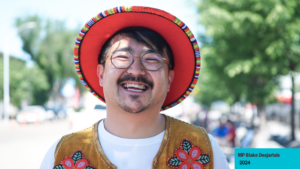
Bringing Two Spirit to the Wider Public
In 1990, at the Third Annual Intertribal Native American, First Nations, Gay and Lesbian American Conference, Elder Myra Laramee put forth the term Two-Spirit. The term is a translation from the Anishnaabemowin (Ojibwe language) term Niizh Manidoowag (neez man-ee-doo-wog). It was added to the front of the Pride acronym (2SLGBTQIA+) in recent years and was even a part of the focus for the Federal 2SLGBTQIA+ Action Plan launched in 2022.
Today, knowledge and understanding about Two-Spirit Peoples is spreading, but is still far behind from where it was before colonization. People like Dr. James Makokis (a Two-Spirit doctor from Kehewin Cree Nation) and MP Blake Desjarlais (a Member of Parliament from Edmonton) are sharing their stories to help more people understand why Two-Spirit Peoples are an essential part of their Nations – and to reduce the stigmatization around people living their authentic lives.
“They are emerging from their long decades of oppression and marginalization working toward re-establishing their rightful roles in their communities as they go through this period of rediscovery,” says Elder Ed Lavalle. “They are working to be recognized, respected and engaged in an integral manner, within Indigenous communities and society in general.”
This Pride Month and National Indigenous History Month, we’re celebrating the bravery of Two-Spirit people coming out and bringing this piece of Indigenous culture to the public forefront. We hope you’ll join us in making room for Peoples who can walk in both worlds to share their gifts and help make this world a more equitable place for everyone.
The role family plays in many Indigenous cultures can’t be understated. Blood familial ties and chosen families can hold the most sacredness and honour for Peoples in Indigenous Nations. The Community at Bissell Centre is no different.
Those strong family ties are especially prevalent at our National Indigenous Peoples’ Day (NIPD) event outside our Community Space (10530 96 Street) every June 21. This is a day of celebration where we block off part of the street, invite performers and artists to share their crafts, and serve some of the best Indigenous cuisine you can find in the city.
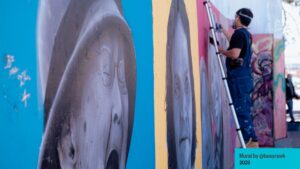
The Reverence held for Elders
Honouring Elders is one of the most important customs of NIPD. The knowledge and teachings these individuals hold in the communities not only preserves the traditional ceremonies and rituals that bring so much vibrancy and life to Indigenous Nations – they can also help guide individuals through challenges and onto the most life-affirming paths.
“One of the most important services we can offer with Bissell’s Indigenous Engagement Program is connecting individuals to Elders,” explains Sarah Higgins, Director of Indigenous Engagement and Integrated Family Services – and a Red River Métis woman. “The teachings and guidance Elders can provide and the connection they foster to Indigenous Nations can help a person decide it’s time to reach out for further supports in their unique journey out of poverty.”
At the NIPD event, you’ll see a tent specifically for Elders to sit in. They’re often accompanied by children from Indigenous Nations, as well, symbolizing how their knowledge will be passed down through generations to ensure the culture and traditions remain a vital part to one’s Indigenous identity.
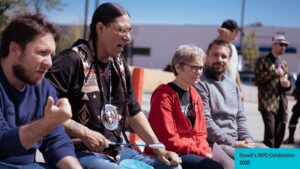
The Crucial Chosen Families Built in the Community
For people accessing the services at Bissell Centre, families by blood aren’t always a part of their lives, yet the importance of family never really goes away for a lot of folks. Creating new chosen families then becomes a part of life in the community.
“It’s not uncommon to see folks in the community calling each other uncle, aunty, or cousin because this is the family they’ve built for themselves,” says Higgins. “Just like a family, these are support systems for each other and we see these connections as real family – just the same as any blood tie.”
Families and communities coming together to celebrate the resiliency of Indigenous Peoples shows how important NIPD is for the folks in downtown Edmonton. And no matter what that family looks like and who makes up that unique family unit, NIPD will have space for all who attend to celebrate the strength, culture, and customs from Indigenous Nations.

We can’t say enough about our Community Space. This is the central hub where folks can come by for a hot meal, hot shower, fresh clothes, and to build relationships with people to grow their support network.
This space is invaluable to the folks who access its services every day. And, this is why our biggest fundraiser of the year, our Coldest Night of the Year walkathon, sees money raised going directly back into the operations and programs in the Community Space. For a lot of folks, this space is so much more than a warm, indoor place to meet daily necessities – it can also be the first step towards finding their unique pathways out of poverty.
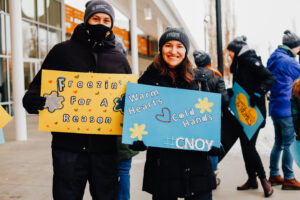
Relationships are everything in the Community Space.
While things like meals and showers might be what first brings people through the doors, they soon learn what other programs might help them along. We offer programs like housing, employment, and mental health, to name a few, which help uncover what barriers people are facing. As staff work to build relationships with people to help find their strengths, folks can start recognizing how best to address these root causes.
No two experiences with houselessness are alike. Building positive relationships can help people recognize their strengths and resiliency – ultimately helping them find their path out of poverty. And, when they’re ready to take those first steps in their journey, Bissell Centre staff help find the resources they need to live a good quality of life.

Every journey is unique – and everyone gives back differently.
Doug has been coming to the Community Space for a few years now. In his own words, it’s his home away from home. The relationships he’s built are like family to him. And like any good family, he finds ways to give back.
The main way Doug gives back to the Community Space is by volunteering in the Community Closet, helping folks find new clothes. Other times, Doug walks around the encampments nearby to see if anyone needs any help. Any way that Doug can help, he wants to offer it to the community that’s given him so much.
“If it weren’t for Bissell Centre, I think we’d all be lost,” says Doug. “They’re helping me out, so I want to help them out too.”
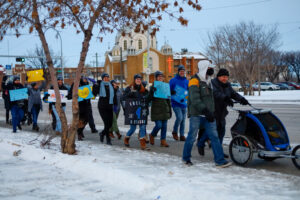
How you can help too.
This year’s Coldest Night of the Year fundraising walk sees all proceeds raised going directly back to the Community Space to support its invaluable operations and programs. Start a team, raise some money, and bring out the whole family for a walk downtown on February 24, 2024. Thank you to all our event sponsors, including our Lead Sponsor Capital Power for providing the single largest sponsorship contribution we have ever received.























